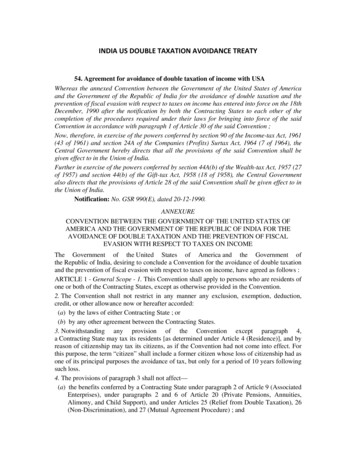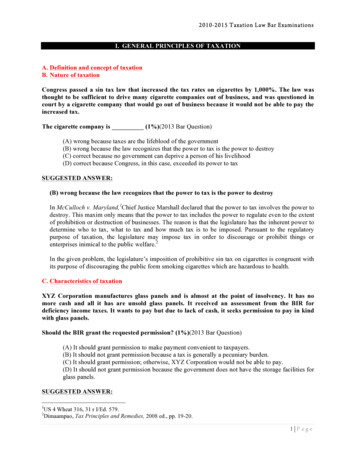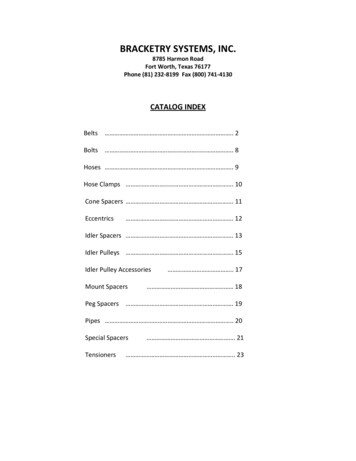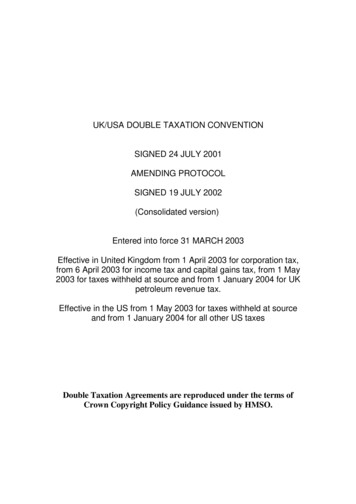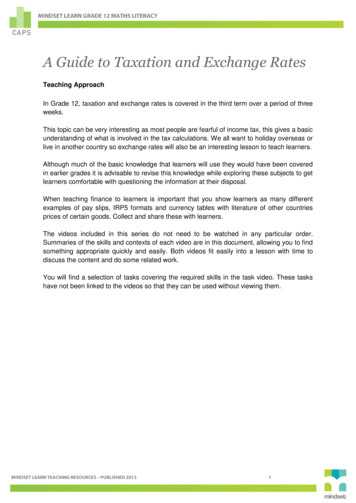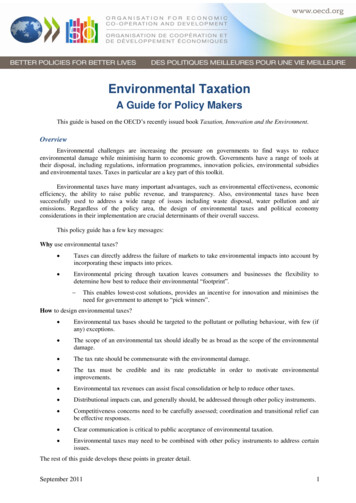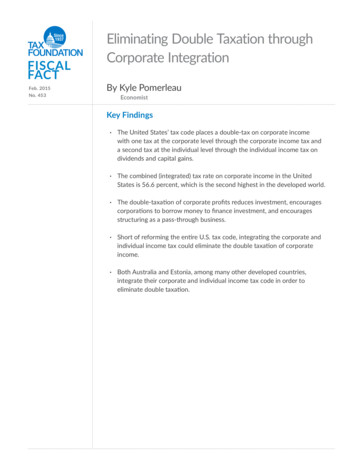
Transcription
FISCALFACTFeb. 2015No. 453Eliminating Double Taxation throughCorporate IntegrationBy Kyle PomerleauEconomistKey Findings·· The United States’ tax code places a double-tax on corporate incomewith one tax at the corporate level through the corporate income tax anda second tax at the individual level through the individual income tax ondividends and capital gains.·· The combined (integrated) tax rate on corporate income in the UnitedStates is 56.6 percent, which is the second highest in the developed world.·· The double-taxation of corporate profits reduces investment, encouragescorporations to borrow money to finance investment, and encouragesstructuring as a pass-through business.·· Short of reforming the entire U.S. tax code, integrating the corporate andindividual income tax could eliminate the double taxation of corporateincome.·· Both Australia and Estonia, among many other developed countries,integrate their corporate and individual income tax code in order toeliminate double taxation.
2IntroductionThe United States’ tax code treats corporations and their shareholders as separate taxableentities. The result is two layers of taxation on corporate income: one at the corporate leveland a second at the shareholder level. This creates a high tax burden on corporate income,increasing the cost of capital. The double taxation of corporate income reduces investmentand distorts business decisions. Specifically, businesses are more likely to borrow money tofinance projects and conduct business as a pass-through entity rather than a corporation.A goal of tax reform is to make the U.S. tax code more neutral and to encourage economicgrowth. One step toward this goal is the elimination of the double tax on corporate income.Short of a complete overhaul of the tax code, integration of the corporate and individualincome tax code is an option to eliminate double taxation. Many developed countries haveintegrated their tax systems in order to mitigate or completely eliminate the double taxationof corporate income.The Double Taxation of Corporate IncomeThe United States has a modified version of what is called a “classical” corporate income taxsystem. A classical corporate tax system treats the corporation and the shareholder as twoseparate taxable entities.1 This means that income and losses earned at the corporate leveland individual level are separate in the eyes of the code, even if they result from the sameeconomic activity.The result is that corporate income is generally subject to two layers of taxation; one tax atthe entity level when the corporation earns income and a second tax at the individual levelwhen that income is passed to its shareholders as either dividends or capital gains. The U.S.system modifies this classic treatment slightly by providing a reduced tax rate on dividendand capital gains income.2Table 1. The Integrated Corporate Tax Ratein the Current U.S. Tax SystemCorporate ProfitsCorporate Income Tax @ 39.1% 100.00 39.10Distributed Dividends 60.90Dividend Income Tax @ 28.7% 17.47Total After-Tax Income 43.43Total Tax Rate56.57%The two layers of tax create a significant tax burden on corporate income (Table 1).Suppose a corporation earns 100 in profit. It needs to pay the corporate income tax of 39.10 (a federal and state rate of 39.1 percent), which leaves the corporation with 60.90in after-tax profits. When the corporation distributes these earnings as a dividend, the12U.S. Department of Treasury, Integration of the Individual and Corporate Tax Systems—Taxing Business Income Once, (Jan. 1992), /Documents/integration.pdf.The top marginal dividend and capital gains income tax rate is 20 percent. In addition, there is a 3.8 percent net investment tax, fora total federal rate of 23.8 percent. State and local governments also tax capital gains and dividend income.
3income is taxed again at the individual level. The shareholder then pays 17.47 in incometaxes (a federal and state rate of 28.7 percent).3 In total, the 100 of corporate profits face acombined marginal tax rate of 56.6 percent.4The same double taxation occurs if the corporation retains its after-tax earnings, ratherthan distribute them as dividends. When corporate earnings are retained, the value of thestock increases to reflect an increase in assets held by the corporation. Shareholders thatdecide to sell their stock will realize a capital gain and pay tax on that gain. The integratedcorporate tax rate through capital gains in the United States is 56.6 percent.There are a few cases in which business income may not necessarily face this doubletaxation. Corporations that finance investments with debt, rather than equity, are able todeduct interest payments made to lenders. This passes the pre-tax earnings to lenders inthe form of interest who pay only one layer of tax on that income.5 Likewise, pass-throughbusinesses—sole proprietorships, S corporations, and partnerships—face no entity level taxat the federal level.6 Their income is passed directly to its owners, who pay individual incometaxes.The United States has High Integrated Tax Rates on CorporateProfitsThe United States’ integrated tax rate on corporate profits is high by international standards.The United States has the second highest integrated tax rate in the OECD (Chart 1),7 whichhas an average integrated tax rate on dividends of about 43 percent (50 percent weightedby GDP).The United States’ integrated tax rate on capital gains is similarly high internationally. TheUnited States’ integrated tax rate on capital gains is also 56.6 percent, which is also thesecond highest in the OECD. The OECD average in 2014 was 39 percent (47.5 percentweighted by GDP).34567This is the combined top marginal individual income tax rate on dividends (23.8 percent) plus the weighted average of state andlocal income tax rates on dividends.The formula is 1-((1-x)*(1-y)), where x is the corporate income tax rate and y is the top marginal personal income tax rate ondividend income.U.S. Department of Treasury, Integration of the Individual and Corporate Tax Systems—Taxing Business Income Once, (Jan. 1992), /Documents/integration.pdf.Some state do not recognize some forms of pass-through business, thus levying the corporate income tax on their net income.Some states also levy franchise taxes on pass-through business income.OECD Tax Database.
4Chart 1. The United States' Integrated Tax Rate on Corporate Profitsis High Compared to Other Developed CountriesThe United States' and OECD Averages, Top Marginal Integrated Corporate Tax Rate,Capital Gains and Dividends, 201460%50403020100United StatesOECD AverageOECD Average(weighted)(simple)Distributed DividendsUnited StatesOECD AverageOECD Average(weighted)(simple)Capital GainsSource: OECD.The Double Taxation of Corporate Profits Creates a Number ofDistortions in the EconomyThe double taxation of corporate earnings creates several economic distortions that havereal effects on both business decisions and the overall economy.Reduced Saving and InvestmentWhen a corporation decides whether to invest in a new project, it needs to make sure itsafter-tax return on the project is high enough to satisfy investors. If the return is too low,the corporation won’t pursue the investment. This minimum required return is the cost ofcapital.A higher tax rate on both corporate income and investment income increases the cost ofcapital. All things being equal, a higher cost of capital makes it less likely that corporationswill invest in projects. This leads to lower levels of investment and a smaller capital stock inthe overall economy. A smaller capital stock means lower worker productivity, lower wages,and slower economic growth.Shift to Non-Corporate Business FormsThe double tax on corporate income also distorts the organizational form of businesses.Unlike traditional C corporations, pass-through business only face one layer of tax. Scorporations, partnerships, sole proprietorships face no entity level tax. All profits fromthese entities are immediately passed through to their owners, who pay the individual
5income tax (Table 2). The top marginal tax rate on pass-through business income (around47.2 percent)8 is a meaningful savings compared to the combined 56.6 percent faced bycorporate income.Table 2. Total Tax Burden on BusinessIncome, C Corporation vs. Pass-ThroughBusinessTraditional CCorporationsPass-throughBusinessesEntity-Level Tax39.1%0.0%Individual-Level Tax28.7%47.2%Total Tax Rate56.6%47.2%Note: Example assumes C corporation distributes dividends.Pass-through Business is a Partnership.Due to the tax differential between the two forms, businesses have an incentive to forgo thebenefits of incorporation in order to receive a higher rate of return on investments. Since1986, when individual income tax rates sharply declined relative to corporate tax rates,more and more business income has been reported by pass-through businesses (Chart 2).In 1980, pass-through businesses only accounted for around 20 percent of total businessincome. As more business activity was performed as a pass-through business, rather than aC corporation, pass-through income steadily climbed. As of 2011, pass-through businessesearned more than 60 percent of all business income.9Chart 2. Pass-Through Businesses Now Earn More Net IncomeThan Traditional C Corporations2000Billions of 2014 Dollars1500Total Pass-Through Net Income (Less Deficit)1000500C corporate Net Income (Less Deficit)01980198519901995200020052010Source: IRS.89The average combined top marginal income tax rate on sole proprietorship and partnership income. Kyle Pomerleau, An Overviewof Pass-through Businesses in the United States, Tax Foundation Special Report No. 227, (Jan. 2015), ough-businesses-united-states.Internal Revenue Service, SOI Tax Stats – Integrated Business Data, 1980–2008, iness-Data; Internal Revenue Service, Business Tax Statistics, 2009–2011, http://www.irs.gov/uac/Tax-Stats-2.
6Debt over EquityWhen a corporation wants to fund a new project it can either finance it through equity (issueof new stock) or it can borrow money. There are many non-tax reasons that a corporationwould choose one funding mechanism over another, but the current tax code treats debtfinancing more favorably than equity financing. Specifically, there are two layers of taxationon equity financing and only one layer of taxation on debt financing.Suppose a corporation decides to raise money to purchase a machine by issuing new stock.When this investment earns a profit the corporation needs to pay the corporate incometax. It then needs to compensate the original investors, so the corporation distributes theafter-tax earnings as dividends. The investors then need to pay tax on the dividends theyreceive from the corporation. This equity-financed project nets two layers of tax, one at thecorporate level and one at the shareholder level.In contrast, the corporation could finance the same investment by borrowing money. Whenthe corporation earns a profit from a debt financed investment, it needs to pay the corporateincome tax on its profits. But before the corporation pays its income tax, it needs to pay itslender back a portion of what it borrowed plus interest. Under current law, corporations areable to deduct interest payments they make to lenders against their taxable income. Thus,profits derived from the debt-financed investment do not face a corporate level tax on theportion of the profit that is paid back in interest.10 The lender then receives the interest asincome and needs to pay tax on it. The debt financed project only nets a single layer of taxat the debt holder’s level.Due to this inequitable treatment of debt and equity in the tax code, the rate of return ondebt financed projects, all else equal, is higher. This encourages corporations to borrow morethan they otherwise would in the absence of the double tax on equity investment.10 U.S. Department of Treasury, Integration of the Individual and Corporate Tax Systems—Taxing Business Income Once, (Jan. policy/Documents/integration.pdf.
7The Unequal Tax Treatment of Equity and Debt Financed InvestmentEquity Financed InvestmentDebt Financed InvestmentInvestor Provides CapitalBank Lends Funds to CorporationCorporation Earns Returnon InvestmentCorporation Earns Returnon Investment and DeductsInterest Payments it makes to LenderTaxNo Taxon return to investmenton return to investment*Corporation PaysDividend to InvestorCorporation PaysInterest to LenderTaxon Investor’sDividend IncomeTaxon Lender’sInterest Income*On the portion of the return paid back to the bank in interest.Source: U.S. Treasury DepartmentIntegrating the Corporate and Individual Income TaxOne of the ultimate goals of fundamental tax reform is to eliminate many of the currentbiases in the tax code caused by the double taxation of corporate income. Short of reformingthe entire tax code, integrating the individual and corporate tax code is a reasonable steptowards fixing the problem. It would lower the combined burden on corporate income andeliminate many of biases in the current system.There are several ways to integrate the corporate tax code. Corporate income can befully taxed at the entity level (a corporate income tax) and then tax exempt when passedto shareholders as dividend income, or corporations could be given a deduction fordividends passed to their shareholders, who pay tax on the dividend income. Alternatively,shareholders and corporations both pay tax on their income, but shareholders can be given acredit to offset taxes the corporation already paid on their behalf.Many developed nations have integrated their corporate and individual tax codes to reduceor eliminate the two layers of taxation on corporate income. The following section providestwo examples of countries with integrated corporate tax codes: Australia and Estonia.
8Australian Credit Imputation SystemAustralia integrates their corporate and individual income tax with a tax credit imputation.This method of integration is a system by which the corporation and the shareholder bothpay part of the corporate income tax, but the shareholder is given a tax credit to offset thetaxes already paid by the corporation. In the end, corporate income is taxed at the marginalincome tax rate of its shareholders, whether the shareholder has a higher or lower tax ratethan the corporation.Table 3. Credit Imputation Method, AustraliaCorporate ProfitsCorporate Income Tax @ 30%After-Tax Corporate ProfitsDistributed DividendsGrossed-up DividendsIndividual Income Tax @ 46.5%Tax Credit for Corporate Taxes PaidNet Personal TaxAfter-Tax Personal IncomeTotal Tax on Corporate Income 100 – 53.50 -- Rate: 100 30 70 70 100 46.50( 30.00) 16.50 53.50 46.5046.50%Suppose a corporation in Australia earns 100 (Table 3). This corporation would need to paythe corporate income tax of 30 percent ( 30). It then decides to pass the remaining 70 ofafter-tax profits to its shareholder.The shareholder receives the 70. For tax purposes, the shareholder then grosses-up thedividends, which means they add back the taxes the corporation already paid on thoseprofits ( 30). This makes their taxable dividend income 100. This shareholder faces amarginal tax rate of 46.5 percent, which means a tentative tax bill of 46.50. The Australiantax code then provides a credit that reduces the shareholder’s tax bill by the amountthe corporation already paid in taxes on those dividends, in this case 30. On net, theshareholder’s tax bill is 16.50. Combine that with the corporation’s bill of 30, the totaltax rate on corporate profits was 46.50, or 46.5 percent of the original 100 of corporateprofit.11In order to make sure corporate income is taxed at the marginal rate of shareholder—whether higher or lower than the corporate income tax rate—the credit against corporatetaxes paid is refundable. For example, if a taxpayer who received dividend’s faced a marginaltax rate of 15 percent, instead of 46.5 percent, they would receive 15 back as a refundso the marginal rate on the corporate income totals 15 (the 30 corporate tax for thecorporation minus 15 tax refund for the individual).11 Only what are called “franked” dividends are eligible for a credit against corporate income taxes paid. Australia has what is called afranking account. This account is set up for each corporation to deposit after-tax income that can be distributed to shareholders.Only income that has first faced the full 30 percent corporate income tax rate is eligible to be deposited. Shareholders that receivedividends from this account are eligible for the tax credit against their dividend income tax. Any dividends that are not from thisaccount are not eligible for the credit.
9Including Australia, seven OECD countries have full or partial credit imputation systems.12(See Appendix Table 2, below)Table 4. Estonian Dividend Exemption SystemCorporate ProfitsCorporate Tax @ 21%After-Tax IncomeDividend IncomeDividend Tax @ 0%After-Tax Personal IncomeTotal Tax on Corporate Income 100 - 79 -- Rate: 100 21 79 79 0 79 2121%Estonian Dividend ExemptionEstonia integrates its corporate and individual income tax code by having a full dividendexemption at the shareholder level. This system of integration levies only one layer of tax oncorporate income at the corporate level. When the shareholder receives dividends from thecorporation, there is no additional tax due.When an Estonian corporation makes a profit and distributes it to shareholders, it must paythe corporate income tax of 21 percent, or 21 on 100 of profit.13When shareholder receives the after-tax profits of 79, no additional tax is due. The totaltax on distributed profits between the corporation and the individual is 21 percent.Including Estonia, 6 OECD countries have full or partial dividend exemptions (AppendixTable 2, below).Dealing with Capital GainsCountries also reduce the double taxation of corporate profits that are retained and leadto capital gains. Nearly all OECD countries either mitigate or eliminate the double taxationwith reduced, or no, capital gains taxes.14 (Appendix Table 3, below). For example, Australiaprovides a 50 percent deduction (50 percent of a capital gain is tax exempt) for capitalgain income. The United States is among the 18 OECD countries that provide a reducedtax rate for capital gains. Nine countries completely exempt capital gains from individuallevel taxation, which eliminates the double taxation of retained earnings. Estonia, uniquely,exempts retained earnings at the corporate level, but taxes capital gains at the individuallevel as ordinary income.12 OECD Tax database, Table II.4, May 2014.13 Estonia only applies its corporate income tax to distributed profits.14 Providing that certain requirements are met. For example, the United States provides a reduced “long-term” capital gains rate of28.7 percent provided that the stock was held for at least a year. PwC, PwC Worldwide Tax Summaries, 2014, sf/ID/PPAA-85RDKF.
10Dealing with Pass-through BusinessesIdeally, business tax reform would bring all business income under the same tax code. Thisway all business income is taxed once and treated equally, regardless of legal form. Shortof a comprehensive reform, efforts to integrate the corporate tax code have to considerpass-through business income. Certain types of integration may create single taxation forall business income, but could leave a large disparity between the taxation of differentlegal forms of business. For example, exempting dividend income at the shareholder levelwould eliminate double taxation for corporate income, but could give favorable treatmentto corporate income compared to pass-through business income. However, if the UnitedStates enacted an imputation credit, the tax disparity between pass-through businessesand corporations could be closed. All business income, pass-through or corporate, would betaxed once at the owner’s or shareholders marginal tax rate.ConclusionThe U.S. tax code double taxes corporate income: once at the corporate level and then againat the shareholder level. This creates a significant tax burden on corporate income, whichincreases the cost of investment, encourages a shift away from the traditional C corporateform towards, and an incentive to finance projects with debt.The United States has one of the highest combined tax rates on corporate income in theindustrialized world. Integrating the corporate and individual income tax would ensure thatcorporate income is only taxed once and would increase the incentive to invest and reducethe incentive to avoid the second layer of tax. This would eliminate the current biasesin the tax code and encourage investment and economic growth. Many countries in theOECD have fully or partially integrated corporate tax systems that eliminate or limit doubletaxation.The Tax Foundation is a501(c)(3) non-partisan,non-profit researchinstitution founded in1937 to educate thepublic on tax policy.Based in Washington,D.C., our economic andpolicy analysis is guidedby the principles of soundtax policy: simplicity,neutrality, transparency,and stability. 2015 Tax FoundationDesigner, Dan CarvajalTax FoundationNational Press Building1325 G Street, NW,Suite 950Washington, DC20005202.464.6200taxfoundation.org
11AppendixAppendix Table 1. Top Marginal Tax Rates: Dividends, Capital Gains, andCorporate Income, OECD Country, 2014CountryIntegratedPersonal Dividend Capital GainsCorporateCorporate Tax RateIncome Tax RateTax RateIncome Tax Rate(Dividends)IntegratedCorporate Tax Rate(Capital 0.0%40.0%36.0%Czech 0%Netherlands25.0%0.0%25.0%43.8%25.0%New lovak %20.0%34.0%20.0%United Kingdom30.6%28.0%21.0%45.1%43.1%United States28.7%28.7%39.1%56.6%56.6%Source: PwC Worldwide Tax Summaries and OECD Tax Database
12Appendix Table 2. Types of Corporate and Individual Tax Systems by Country, 2014Classical SystemAustriaBelgiumCzech landPortugalSpainSwitzerlandUnited StatesFull Credit ImputationAustraliaCanadaChileMexicoNew ZealandPartial CreditImputationFull DividendExemptionPartial DividendExemptionKoreaUnited KingdomEstoniaSlovak RepublicFinlandFranceLuxembourgTurkeySource: OECD Tax Database, Table II.4, 2014Appendix Table 3. Tax Treatment of Capital Gains by OECD Country,2014Ordinary IncomeDenmarkEstoniaFinlandNorwaySlovak RepublicReduced denUnited KingdomUnited StatesSource: PwC Worldwide Tax Summaries, 201450 Percent ExemptionFully ExemptAustraliaCanadaBelgiumCzech RepublicKoreaLuxembourgNetherlandsNew ZealandSloveniaSwitzerlandTurkeyOtherHungaryNorway
3 income is taxed again at the individual level. The shareholder then pays 17.47 in income taxes (a federal and state rate of 28.7 percent).3 In total, the 100 of corporate profits face a combined marginal tax rate of 56.6 percent.4 The same double taxation occurs if the corporation retains its after-tax earnings, rather

